Yu Cheng
ThinkMorph: Emergent Properties in Multimodal Interleaved Chain-of-Thought Reasoning
Oct 30, 2025Abstract:Multimodal reasoning requires iterative coordination between language and vision, yet it remains unclear what constitutes a meaningful interleaved chain of thought. We posit that text and image thoughts should function as complementary, rather than isomorphic, modalities that mutually advance reasoning. Guided by this principle, we build ThinkMorph, a unified model fine-tuned on 24K high-quality interleaved reasoning traces spanning tasks with varying visual engagement. ThinkMorph learns to generate progressive text-image reasoning steps that concretely manipulate visual content while maintaining coherent verbal logic. It delivers large gains on vision-centric benchmarks (averaging 34.7% over the base model) and generalizes to out-of-domain tasks, matching or surpassing larger and proprietary VLMs. Beyond performance, ThinkMorph exhibits emergent multimodal intelligence, including unseen visual manipulation skills, adaptive switching between reasoning modes, and better test-time scaling through diversified multimodal thoughts.These findings suggest promising directions for characterizing the emergent capabilities of unified models for multimodal reasoning.
Nirvana: A Specialized Generalist Model With Task-Aware Memory Mechanism
Oct 30, 2025Abstract:Specialized Generalist Models (SGMs) aim to preserve broad capabilities while achieving expert-level performance in target domains. However, traditional LLM structures including Transformer, Linear Attention, and hybrid models do not employ specialized memory mechanism guided by task information. In this paper, we present Nirvana, an SGM with specialized memory mechanism, linear time complexity, and test-time task information extraction. Besides, we propose the Task-Aware Memory Trigger ($\textit{Trigger}$) that flexibly adjusts memory mechanism based on the current task's requirements. In Trigger, each incoming sample is treated as a self-supervised fine-tuning task, enabling Nirvana to adapt its task-related parameters on the fly to domain shifts. We also design the Specialized Memory Updater ($\textit{Updater}$) that dynamically memorizes the context guided by Trigger. We conduct experiments on both general language tasks and specialized medical tasks. On a variety of natural language modeling benchmarks, Nirvana achieves competitive or superior results compared to the existing LLM structures. To prove the effectiveness of Trigger on specialized tasks, we test Nirvana's performance on a challenging medical task, i.e., Magnetic Resonance Imaging (MRI). We post-train frozen Nirvana backbone with lightweight codecs on paired electromagnetic signals and MRI images. Despite the frozen Nirvana backbone, Trigger guides the model to adapt to the MRI domain with the change of task-related parameters. Nirvana achieves higher-quality MRI reconstruction compared to conventional MRI models as well as the models with traditional LLMs' backbone, and can also generate accurate preliminary clinical reports accordingly.
Native Hybrid Attention for Efficient Sequence Modeling
Oct 08, 2025



Abstract:Transformers excel at sequence modeling but face quadratic complexity, while linear attention offers improved efficiency but often compromises recall accuracy over long contexts. In this work, we introduce Native Hybrid Attention (NHA), a novel hybrid architecture of linear and full attention that integrates both intra \& inter-layer hybridization into a unified layer design. NHA maintains long-term context in key-value slots updated by a linear RNN, and augments them with short-term tokens from a sliding window. A single \texttt{softmax attention} operation is then applied over all keys and values, enabling per-token and per-head context-dependent weighting without requiring additional fusion parameters. The inter-layer behavior is controlled through a single hyperparameter, the sliding window size, which allows smooth adjustment between purely linear and full attention while keeping all layers structurally uniform. Experimental results show that NHA surpasses Transformers and other hybrid baselines on recall-intensive and commonsense reasoning tasks. Furthermore, pretrained LLMs can be structurally hybridized with NHA, achieving competitive accuracy while delivering significant efficiency gains. Code is available at https://github.com/JusenD/NHA.
ExGRPO: Learning to Reason from Experience
Oct 02, 2025
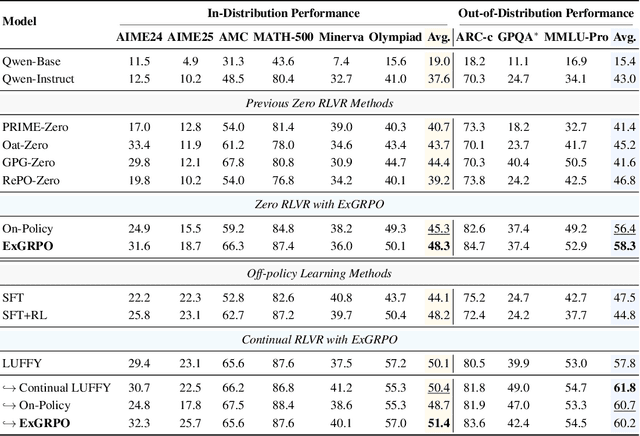
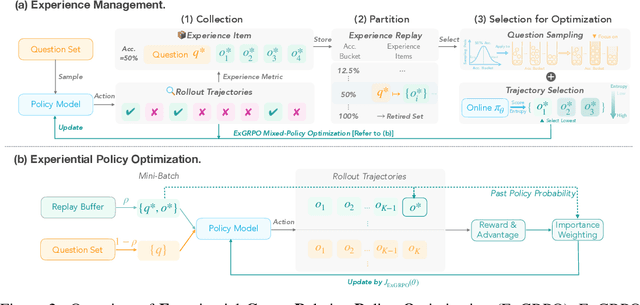
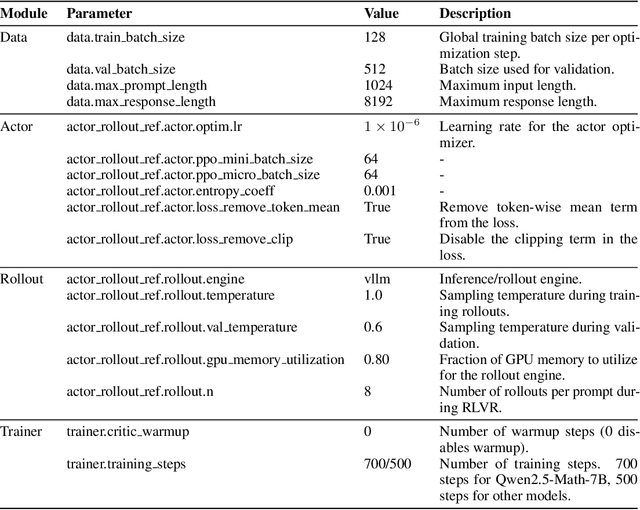
Abstract:Reinforcement learning from verifiable rewards (RLVR) is an emerging paradigm for improving the reasoning ability of large language models. However, standard on-policy training discards rollout experiences after a single update, leading to computational inefficiency and instability. While prior work on RL has highlighted the benefits of reusing past experience, the role of experience characteristics in shaping learning dynamics of large reasoning models remains underexplored. In this paper, we are the first to investigate what makes a reasoning experience valuable and identify rollout correctness and entropy as effective indicators of experience value. Based on these insights, we propose ExGRPO (Experiential Group Relative Policy Optimization), a framework that organizes and prioritizes valuable experiences, and employs a mixed-policy objective to balance exploration with experience exploitation. Experiments on five backbone models (1.5B-8B parameters) show that ExGRPO consistently improves reasoning performance on mathematical/general benchmarks, with an average gain of +3.5/7.6 points over on-policy RLVR. Moreover, ExGRPO stabilizes training on both stronger and weaker models where on-policy methods fail. These results highlight principled experience management as a key ingredient for efficient and scalable RLVR.
Reasoning over Boundaries: Enhancing Specification Alignment via Test-time Delibration
Sep 18, 2025Abstract:Large language models (LLMs) are increasingly applied in diverse real-world scenarios, each governed by bespoke behavioral and safety specifications (spec) custom-tailored by users or organizations. These spec, categorized into safety-spec and behavioral-spec, vary across scenarios and evolve with changing preferences and requirements. We formalize this challenge as specification alignment, focusing on LLMs' ability to follow dynamic, scenario-specific spec from both behavioral and safety perspectives. To address this challenge, we propose Align3, a lightweight method that employs Test-Time Deliberation (TTD) with hierarchical reflection and revision to reason over the specification boundaries. We further present SpecBench, a unified benchmark for measuring specification alignment, covering 5 scenarios, 103 spec, and 1,500 prompts. Experiments on 15 reasoning and 18 instruct models with several TTD methods, including Self-Refine, TPO, and MoreThink, yield three key findings: (i) test-time deliberation enhances specification alignment; (ii) Align3 advances the safety-helpfulness trade-off frontier with minimal overhead; (iii) SpecBench effectively reveals alignment gaps. These results highlight the potential of test-time deliberation as an effective strategy for reasoning over the real-world specification boundaries.
HiPhO: How Far Are (M)LLMs from Humans in the Latest High School Physics Olympiad Benchmark?
Sep 10, 2025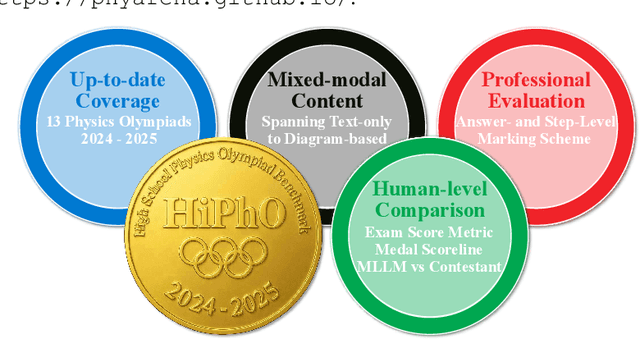

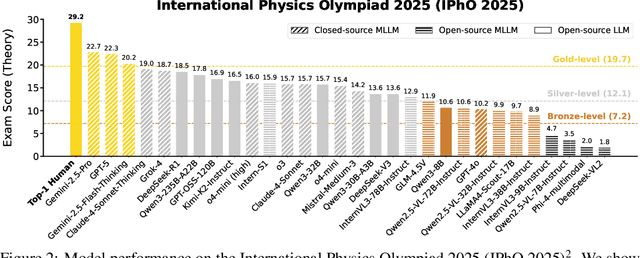

Abstract:Recently, the physical capabilities of (M)LLMs have garnered increasing attention. However, existing benchmarks for physics suffer from two major gaps: they neither provide systematic and up-to-date coverage of real-world physics competitions such as physics Olympiads, nor enable direct performance comparison with humans. To bridge these gaps, we present HiPhO, the first benchmark dedicated to high school physics Olympiads with human-aligned evaluation. Specifically, HiPhO highlights three key innovations. (1) Comprehensive Data: It compiles 13 latest Olympiad exams from 2024-2025, spanning both international and regional competitions, and covering mixed modalities that encompass problems spanning text-only to diagram-based. (2) Professional Evaluation: We adopt official marking schemes to perform fine-grained grading at both the answer and step level, fully aligned with human examiners to ensure high-quality and domain-specific evaluation. (3) Comparison with Human Contestants: We assign gold, silver, and bronze medals to models based on official medal thresholds, thereby enabling direct comparison between (M)LLMs and human contestants. Our large-scale evaluation of 30 state-of-the-art (M)LLMs shows that: across 13 exams, open-source MLLMs mostly remain at or below the bronze level; open-source LLMs show promising progress with occasional golds; closed-source reasoning MLLMs can achieve 6 to 12 gold medals; and most models still have a significant gap from full marks. These results highlight a substantial performance gap between open-source models and top students, the strong physical reasoning capabilities of closed-source reasoning models, and the fact that there is still significant room for improvement. HiPhO, as a rigorous, human-aligned, and Olympiad-focused benchmark for advancing multimodal physical reasoning, is open-source and available at https://github.com/SciYu/HiPhO.
Interleaving Reasoning for Better Text-to-Image Generation
Sep 09, 2025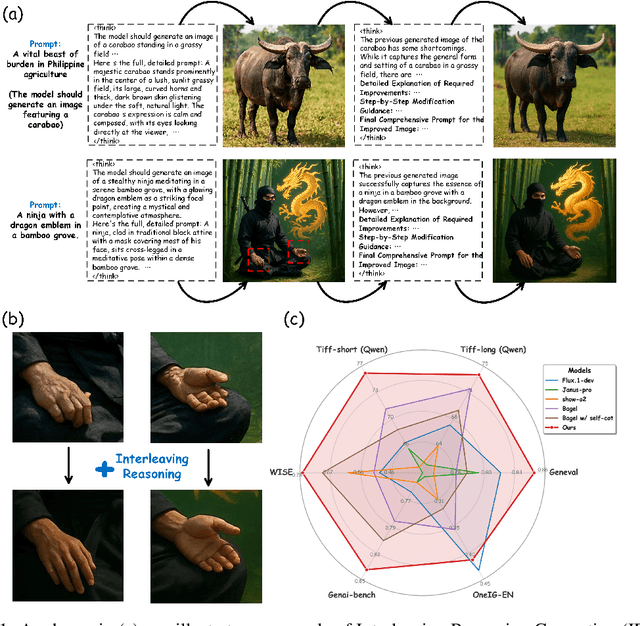
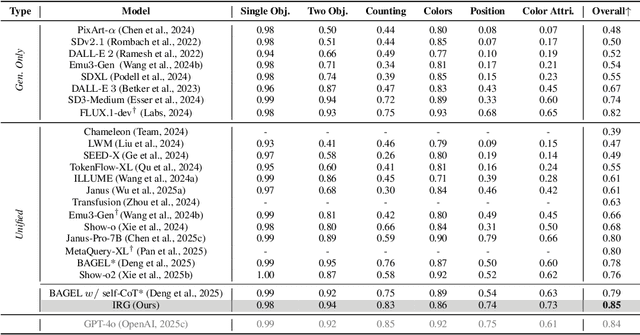

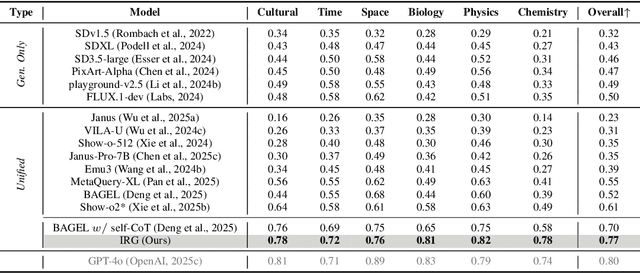
Abstract:Unified multimodal understanding and generation models recently have achieve significant improvement in image generation capability, yet a large gap remains in instruction following and detail preservation compared to systems that tightly couple comprehension with generation such as GPT-4o. Motivated by recent advances in interleaving reasoning, we explore whether such reasoning can further improve Text-to-Image (T2I) generation. We introduce Interleaving Reasoning Generation (IRG), a framework that alternates between text-based thinking and image synthesis: the model first produces a text-based thinking to guide an initial image, then reflects on the result to refine fine-grained details, visual quality, and aesthetics while preserving semantics. To train IRG effectively, we propose Interleaving Reasoning Generation Learning (IRGL), which targets two sub-goals: (1) strengthening the initial think-and-generate stage to establish core content and base quality, and (2) enabling high-quality textual reflection and faithful implementation of those refinements in a subsequent image. We curate IRGL-300K, a dataset organized into six decomposed learning modes that jointly cover learning text-based thinking, and full thinking-image trajectories. Starting from a unified foundation model that natively emits interleaved text-image outputs, our two-stage training first builds robust thinking and reflection, then efficiently tunes the IRG pipeline in the full thinking-image trajectory data. Extensive experiments show SoTA performance, yielding absolute gains of 5-10 points on GenEval, WISE, TIIF, GenAI-Bench, and OneIG-EN, alongside substantial improvements in visual quality and fine-grained fidelity. The code, model weights and datasets will be released in: https://github.com/Osilly/Interleaving-Reasoning-Generation .
Synthesizing Sheet Music Problems for Evaluation and Reinforcement Learning
Sep 04, 2025Abstract:Enhancing the ability of Large Language Models (LLMs) and Multimodal Large Language Models (MLLMs) to interpret sheet music is a crucial step toward building AI musicians. However, current research lacks both evaluation benchmarks and training data for sheet music reasoning. To address this, we propose the idea of synthesizing sheet music problems grounded in music theory, which can serve both as evaluation benchmarks and as training data for reinforcement learning with verifiable rewards (RLVR). We introduce a data synthesis framework that generates verifiable sheet music questions in both textual and visual modalities, leading to the Synthetic Sheet Music Reasoning Benchmark (SSMR-Bench) and a complementary training set. Evaluation results on SSMR-Bench show the importance of models' reasoning abilities in interpreting sheet music. At the same time, the poor performance of Gemini 2.5-Pro highlights the challenges that MLLMs still face in interpreting sheet music in a visual format. By leveraging synthetic data for RLVR, Qwen3-8B-Base and Qwen2.5-VL-Instruct achieve improvements on the SSMR-Bench. Besides, the trained Qwen3-8B-Base surpasses GPT-4 in overall performance on MusicTheoryBench and achieves reasoning performance comparable to GPT-4 with the strategies of Role play and Chain-of-Thought. Notably, its performance on math problems also improves relative to the original Qwen3-8B-Base. Furthermore, our results show that the enhanced reasoning ability can also facilitate music composition. In conclusion, we are the first to propose the idea of synthesizing sheet music problems based on music theory rules, and demonstrate its effectiveness not only in advancing model reasoning for sheet music understanding but also in unlocking new possibilities for AI-assisted music creation.
Improved Personalized Headline Generation via Denoising Fake Interests from Implicit Feedback
Aug 10, 2025Abstract:Accurate personalized headline generation hinges on precisely capturing user interests from historical behaviors. However, existing methods neglect personalized-irrelevant click noise in entire historical clickstreams, which may lead to hallucinated headlines that deviate from genuine user preferences. In this paper, we reveal the detrimental impact of click noise on personalized generation quality through rigorous analysis in both user and news dimensions. Based on these insights, we propose a novel Personalized Headline Generation framework via Denoising Fake Interests from Implicit Feedback (PHG-DIF). PHG-DIF first employs dual-stage filtering to effectively remove clickstream noise, identified by short dwell times and abnormal click bursts, and then leverages multi-level temporal fusion to dynamically model users' evolving and multi-faceted interests for precise profiling. Moreover, we release DT-PENS, a new benchmark dataset comprising the click behavior of 1,000 carefully curated users and nearly 10,000 annotated personalized headlines with historical dwell time annotations. Extensive experiments demonstrate that PHG-DIF substantially mitigates the adverse effects of click noise and significantly improves headline quality, achieving state-of-the-art (SOTA) results on DT-PENS. Our framework implementation and dataset are available at https://github.com/liukejin-up/PHG-DIF.
* Accepted by the 34th ACM International Conference on Information and Knowledge Management (CIKM '25), Full Research Papers track
SafeWork-R1: Coevolving Safety and Intelligence under the AI-45$^{\circ}$ Law
Jul 24, 2025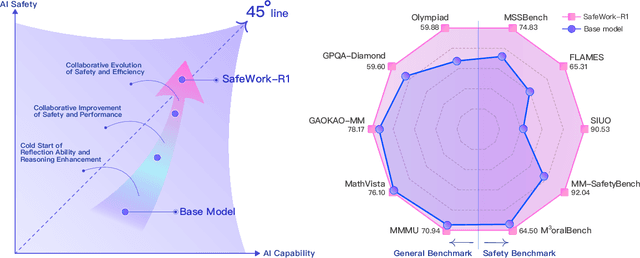
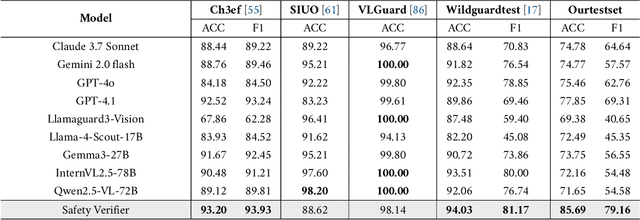
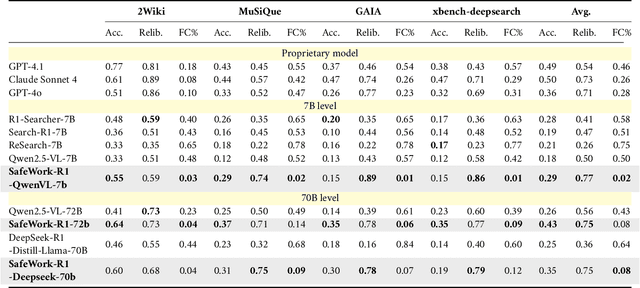

Abstract:We introduce SafeWork-R1, a cutting-edge multimodal reasoning model that demonstrates the coevolution of capabilities and safety. It is developed by our proposed SafeLadder framework, which incorporates large-scale, progressive, safety-oriented reinforcement learning post-training, supported by a suite of multi-principled verifiers. Unlike previous alignment methods such as RLHF that simply learn human preferences, SafeLadder enables SafeWork-R1 to develop intrinsic safety reasoning and self-reflection abilities, giving rise to safety `aha' moments. Notably, SafeWork-R1 achieves an average improvement of $46.54\%$ over its base model Qwen2.5-VL-72B on safety-related benchmarks without compromising general capabilities, and delivers state-of-the-art safety performance compared to leading proprietary models such as GPT-4.1 and Claude Opus 4. To further bolster its reliability, we implement two distinct inference-time intervention methods and a deliberative search mechanism, enforcing step-level verification. Finally, we further develop SafeWork-R1-InternVL3-78B, SafeWork-R1-DeepSeek-70B, and SafeWork-R1-Qwen2.5VL-7B. All resulting models demonstrate that safety and capability can co-evolve synergistically, highlighting the generalizability of our framework in building robust, reliable, and trustworthy general-purpose AI.
 Add to Chrome
Add to Chrome Add to Firefox
Add to Firefox Add to Edge
Add to Edge